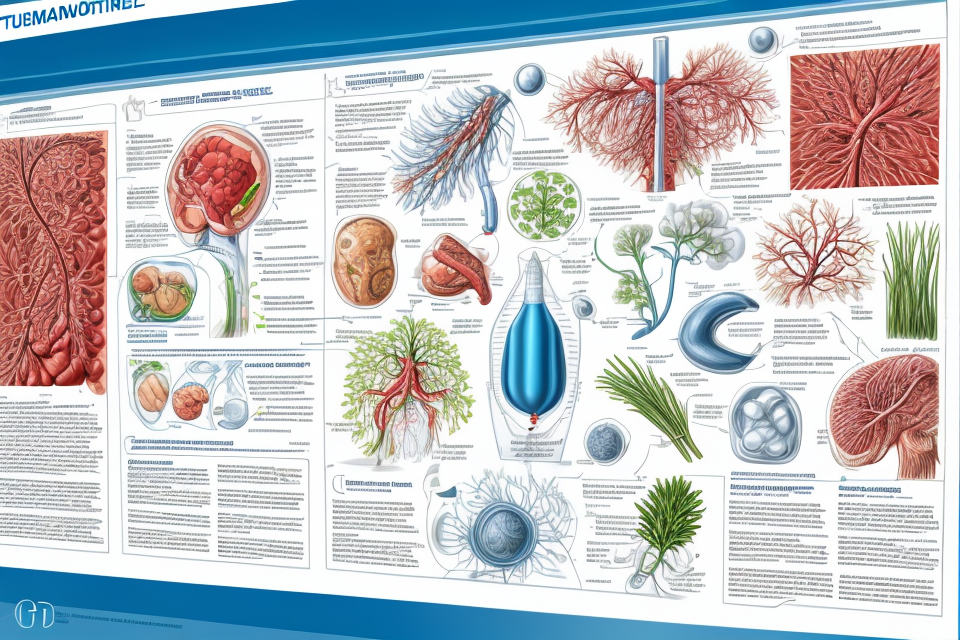
Our bodies are designed to maintain a stable internal temperature, despite external fluctuations in the environment. However, when the temperature rises above the normal range, our bodies need to take action to prevent overheating. This is a critical process that ensures our survival, and it involves several intricate mechanisms that work together to regulate our body temperature. In this article, we will explore how our bodies respond to high temperatures and the mechanisms that help us to maintain a stable internal temperature. From sweating to vasoconstriction, we will delve into the fascinating world of thermoregulation and discover how our bodies keep us cool in hot weather. So, buckle up and get ready to learn about the incredible ways in which our bodies protect us from overheating.
The body regulates temperature through a process called thermoregulation. This process involves the use of several mechanisms, including the regulation of body temperature through sweating, the dilation and constriction of blood vessels, and the control of body heat production through metabolic processes. When the body’s temperature rises above a certain level, these mechanisms work together to help prevent overheating and maintain a stable body temperature. For example, when the body temperature rises, the body may produce more sweat to help cool the skin and regulate body temperature. Additionally, the body may dilate or constrict blood vessels to increase or decrease blood flow to the skin, which can also help regulate body temperature. Overall, the body has several mechanisms in place to help regulate temperature and prevent overheating.
Understanding Body Temperature
Normal Body Temperature Range
Your body’s internal temperature is regulated by various mechanisms to maintain a healthy balance. The normal body temperature range is typically measured in degrees Fahrenheit (°F) or degrees Celsius (°C). The oral temperature range for humans is generally between 97.2°F to 99.9°F (36.8°C to 37.7°C), while the rectal temperature range is slightly higher, between 99.9°F to 100.9°F (37.7°C to 38.3°C).
The average normal body temperature for adults is usually around 98.6°F (37°C), which is often considered the standard for a healthy body. However, it’s important to note that this temperature can fluctuate throughout the day due to various factors, such as exercise, food intake, and external environmental conditions.
Additionally, the normal body temperature range may differ slightly among individuals and can be influenced by age, sex, and other personal factors. It’s essential to understand these variations to better comprehend how your body regulates temperature to prevent overheating.
Regulation of Body Temperature
Your body’s temperature is constantly regulated to maintain a stable internal environment, which is essential for proper functioning of biological processes. The body’s temperature is regulated by a complex interplay of various physiological mechanisms.
One of the key organs involved in regulating body temperature is the hypothalamus, a small region located in the brain. The hypothalamus acts as a thermostat, sensing changes in body temperature and initiating appropriate responses to maintain a stable internal environment. When the body’s temperature rises, the hypothalamus triggers a range of physiological responses to help cool the body down.
Another mechanism that helps regulate body temperature is sweating. When the body’s temperature rises, sweat glands located in the skin produce sweat, which evaporates and helps to cool the body down. Sweating is a highly effective way of regulating body temperature, especially in hot and humid environments.
In addition to sweating, the body also regulates temperature through vasoconstriction and vasodilation. Vasoconstriction involves the constriction of blood vessels, which reduces blood flow to the skin and helps to conserve heat. Vasodilation, on the other hand, involves the dilation of blood vessels, which increases blood flow to the skin and helps to dissipate heat.
Overall, the regulation of body temperature is a complex process that involves multiple physiological mechanisms. By understanding how the body regulates temperature, we can better understand how to maintain a healthy internal environment and prevent overheating.
Factors Affecting Body Temperature
Environmental Factors
- Ambient temperature
- Humidity
- Sun exposure
Ambient Temperature
The ambient temperature of the surroundings plays a significant role in regulating body temperature. When the ambient temperature is high, the body’s natural cooling mechanisms work harder to maintain a stable internal temperature. Conversely, when the ambient temperature is low, the body may not be able to maintain its internal temperature, leading to overheating.
Humidity
Humidity levels also affect the body’s ability to regulate temperature. High humidity levels can make it more difficult for the body to release heat through sweating, as the air is already saturated with moisture. This can lead to a higher body temperature and an increased risk of overheating.
Sun Exposure
Sun exposure is another environmental factor that can affect body temperature. When the body is exposed to direct sunlight, it can cause the body’s core temperature to rise, leading to overheating. Additionally, prolonged exposure to the sun can cause dehydration, which can further impair the body’s ability to regulate temperature.
Overall, environmental factors such as ambient temperature, humidity, and sun exposure can significantly impact the body’s ability to regulate temperature and prevent overheating. Understanding how these factors affect the body can help individuals take appropriate measures to maintain a stable internal temperature and prevent overheating.
Physical Factors
Exercise
Exercise is a physical factor that can affect body temperature. When you engage in physical activity, your body generates heat through muscle contractions and increases blood flow. The intensity and duration of exercise determine how much heat your body produces. For example, a brisk walk may slightly increase body temperature, while a high-intensity workout can cause a more significant rise in temperature.
Clothing
Clothing is another physical factor that can impact body temperature. Wearing lightweight, breathable fabrics can help regulate body temperature by allowing air to circulate around the body and allowing perspiration to evaporate. On the other hand, wearing tight or dark-colored clothing can trap heat and make it harder for the body to cool down.
Body Weight
Body weight is also a physical factor that can affect body temperature. Individuals with a higher body weight tend to have a higher metabolic rate, which generates more heat. This increased heat production can make it harder for the body to regulate its temperature, particularly during physical activity. On the other hand, individuals with a lower body weight may have an easier time regulating their temperature due to their lower heat production.
Signs of Overheating
Heat Stroke
Heat stroke is a severe condition that occurs when the body’s core temperature rises above 104°F (40°C). It is a medical emergency that requires immediate treatment.
Symptoms
The symptoms of heat stroke can vary depending on the severity of the condition. Some common symptoms include:
- High body temperature
- Headache
- Confusion
- Dizziness
- Nausea and vomiting
- Seizures
- Loss of consciousness
Causes
Heat stroke is caused by prolonged exposure to high temperatures, which can occur during hot weather or from being in a hot environment for an extended period. It can also be caused by engaging in strenuous physical activity in hot weather without adequate hydration or taking certain medications that affect body temperature regulation.
Treatment
Treatment for heat stroke involves reducing the body’s core temperature as quickly as possible. This may involve:
- Moving the person to a cooler environment
- Spraying the person with water or using a cool bath or shower
- Using ice packs or cold towels to cool the person’s body
- Providing the person with fluids to drink
- Administering medications to reduce fever and seizures
It is essential to seek medical attention immediately if you suspect that someone is experiencing heat stroke. Delayed treatment can lead to serious complications or even death.
Heat Exhaustion
Heat exhaustion is a condition that occurs when the body is unable to regulate its temperature properly and becomes overheated. It is a milder form of heat-related illness compared to heat stroke, but it can still have serious consequences if left untreated.
Symptoms
The symptoms of heat exhaustion can vary depending on the severity of the condition, but they typically include:
- Dizziness or lightheadedness
- Fatigue or weakness
- Muscle cramps
- Nausea or vomiting
- Cool, clammy skin
- Rapid heartbeat
- Fainting or passing out
Causes
Heat exhaustion is caused by prolonged exposure to high temperatures, which can cause the body’s temperature to rise above normal levels. This can occur when the body is unable to dissipate heat quickly enough, or when the body loses too much fluid through sweating.
Treatment
Treatment for heat exhaustion involves removing the person from the hot environment, cooling their body down, and providing them with fluids to rehydrate their body. In some cases, medical attention may be necessary to treat any complications that arise from the condition.
Preventing Heat Exhaustion
The best way to prevent heat exhaustion is to take steps to avoid prolonged exposure to high temperatures. This can include:
- Staying hydrated by drinking plenty of fluids
- Taking breaks in a cool, shaded area
- Wearing loose, lightweight clothing
- Avoiding alcohol and cigarettes, which can increase dehydration and impair the body’s ability to regulate its temperature
- Using fans or air conditioning to cool down
- Avoiding strenuous activity during the hottest parts of the day
By taking these precautions, you can help to prevent heat exhaustion and keep your body functioning properly in hot weather.
Strategies to Prevent Overheating
Hydration
When it comes to regulating body temperature, hydration plays a crucial role. Fluids and electrolytes are essential for maintaining proper body function, and dehydration can have severe consequences on one’s health.
Fluids and Electrolytes
The human body consists of about 60% water, and it is essential to maintain a proper balance of fluids and electrolytes to ensure that the body’s temperature remains stable. Fluids help regulate body temperature by dissipating heat through sweating, while electrolytes help maintain the balance of fluids in the body.
Dehydration and its Consequences
Dehydration occurs when the body loses more fluids than it takes in, and it can have severe consequences on one’s health. When the body is dehydrated, it cannot regulate its temperature properly, leading to overheating. In severe cases, dehydration can lead to heat stroke, a potentially life-threatening condition.
It is crucial to stay hydrated, especially during hot weather or physical activity. Drinking plenty of water and electrolyte-rich beverages can help maintain the balance of fluids in the body and prevent dehydration. Additionally, it is essential to monitor one’s fluid intake and pay attention to signs of dehydration, such as dry mouth, dark urine, and fatigue.
In conclusion, hydration is a critical strategy for preventing overheating. By maintaining a proper balance of fluids and electrolytes, one can ensure that the body’s temperature remains stable and prevent the consequences of dehydration.
Clothing
Clothing plays a significant role in regulating body temperature. The type of clothing you wear can either keep you cool or make you feel hotter. Here are some clothing strategies to prevent overheating:
- Light-colored, loose-fitting clothing: Light-colored clothes reflect more sunlight than dark-colored clothes, which helps keep you cooler. Loose-fitting clothes allow air to circulate around your body, allowing heat to dissipate more efficiently.
- Breathable fabrics: Breathable fabrics like cotton, linen, and mesh allow moisture to evaporate, which helps keep you cool. Tightly woven fabrics, on the other hand, can trap heat against your skin, making you feel hotter.
- Hats and sunscreen: Wearing a hat can help protect your face and ears from the sun, which can help keep you cool. Sunscreen can also help protect your skin from the harmful effects of UV rays, which can cause your body temperature to rise.
By choosing the right clothing, you can help your body regulate its temperature more effectively and prevent overheating.
Behavioral Changes
Reducing Physical Activity
During times of high heat, it is important to reduce physical activity to prevent overheating. This can include taking breaks from outdoor activities or reducing the intensity of exercise. It is important to listen to your body and take breaks when needed to prevent overheating.
Seeking Shade or Air-Conditioned Areas
Seeking shade or air-conditioned areas can help to prevent overheating. This can include seeking shade during outdoor activities or spending time in air-conditioned buildings during hot weather. It is important to find ways to stay cool and avoid overheating.
Adjusting Work Schedules During Peak Heat Times
Adjusting work schedules during peak heat times can help to prevent overheating. This can include scheduling outdoor activities during cooler parts of the day or adjusting work schedules to avoid times of high heat. It is important to find ways to stay cool and avoid overheating.
Medical Conditions and Medications
Certain medical conditions and medications can make individuals more susceptible to overheating. It is essential to understand these factors to prevent overheating and protect one’s health.
- Heat intolerance: Heat intolerance occurs when the body has difficulty regulating its temperature in response to high temperatures. This condition can be caused by various factors, such as dehydration, certain medications, or chronic health issues. Individuals with heat intolerance may experience symptoms such as dizziness, headache, or fatigue when exposed to high temperatures.
- Certain medications: Some medications can impair the body’s ability to regulate its temperature, making individuals more susceptible to overheating. Anticholinergics, for example, block the action of acetylcholine, a neurotransmitter that plays a role in regulating body temperature. Diuretics, on the other hand, increase urine production and can lead to dehydration, which can also contribute to overheating.
- Chronic conditions: Certain chronic health conditions, such as heart or lung disease, can make it more difficult for the body to regulate its temperature. Individuals with these conditions may be more prone to overheating, especially during physical activity or in hot weather. It is crucial for individuals with chronic health conditions to take extra precautions to prevent overheating and protect their health.
When to Seek Medical Attention
In certain situations, it’s crucial to seek medical attention for conditions related to overheating. Some of these situations include:
- Heat stroke: This is a severe condition that occurs when the body’s temperature rises above 104°F (40°C). Symptoms of heat stroke include confusion, seizures, headache, dizziness, and fainting. If you suspect someone is experiencing heat stroke, it’s important to seek immediate medical attention.
- Heat exhaustion: This condition is characterized by symptoms such as excessive sweating, fatigue, headache, dizziness, and nausea. If these symptoms persist or worsen, it’s important to seek medical attention.
- Suspected dehydration: Dehydration can occur due to excessive sweating and can lead to serious health complications. If you suspect dehydration, it’s important to seek medical attention to prevent further complications.
- Chronic medical conditions exacerbated by heat: Certain chronic medical conditions, such as heart disease, diabetes, and asthma, can be exacerbated by excessive heat. If you have a chronic medical condition and are experiencing worsening symptoms during times of high heat, it’s important to seek medical attention.
FAQs
1. How does the body regulate temperature?
The body regulates temperature through a complex system of mechanisms that work together to maintain a stable internal temperature. The process involves various organs, including the brain, heart, blood vessels, sweat glands, and the hypothalamus. The hypothalamus acts as the body’s thermostat, monitoring the body’s temperature and triggering appropriate responses to maintain a stable temperature.
2. What are the ways the body regulates temperature?
The body regulates temperature through several mechanisms, including sweating, vasodilation, and shivering. Sweating is the body’s way of getting rid of excess heat, and it is mainly controlled by the hypothalamus. Vasodilation is the widening of blood vessels, which allows more blood to flow near the surface of the skin, where heat can be dissipated more efficiently. Shivering is a muscular response that generates heat by contracting and relaxing muscles, which creates friction and generates heat.
3. What happens when the body overheats?
When the body overheats, the body’s thermostat, the hypothalamus, triggers various responses to cool the body down. These responses include sweating, vasodilation, and shivering. If the body cannot cool down through these mechanisms, it may develop heat exhaustion or heat stroke, which can be life-threatening.
4. How can I prevent overheating?
To prevent overheating, it is important to stay hydrated, wear loose and light-colored clothing, and avoid spending too much time in direct sunlight. It is also important to take breaks and rest in a cool place if you are engaged in physical activity. If you are in a hot environment, such as a sauna or a hot tub, it is important to monitor your body temperature and take steps to cool down if you start to feel overheated.







